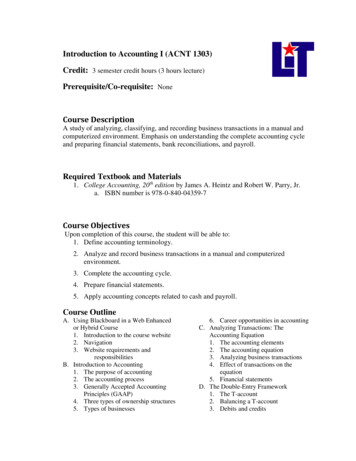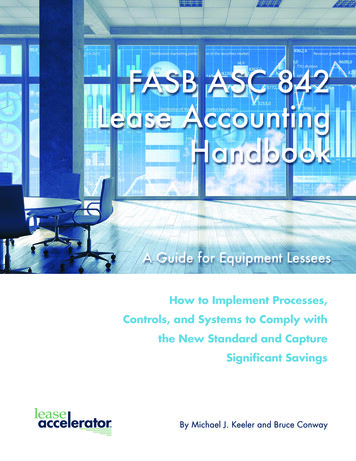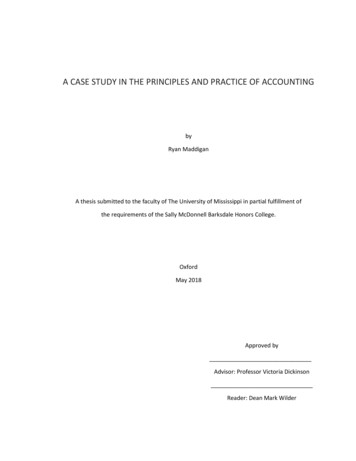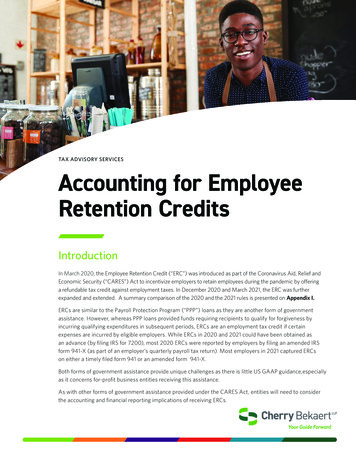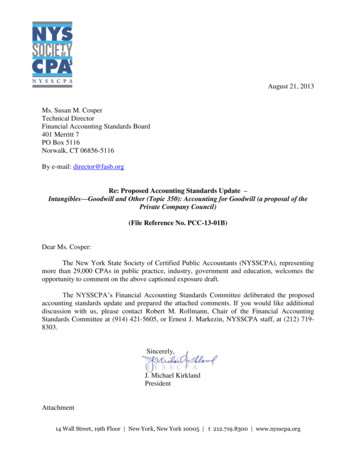
Transcription
August 21, 2013Ms. Susan M. CosperTechnical DirectorFinancial Accounting Standards Board401 Merritt 7PO Box 5116Norwalk, CT 06856-5116By e-mail: director@fasb.orgRe: Proposed Accounting Standards Update –Intangibles—Goodwill and Other (Topic 350): Accounting for Goodwill (a proposal of thePrivate Company Council)(File Reference No. PCC-13-01B)Dear Ms. Cosper:The New York State Society of Certified Public Accountants (NYSSCPA), representingmore than 29,000 CPAs in public practice, industry, government and education, welcomes theopportunity to comment on the above captioned exposure draft.The NYSSCPA’s Financial Accounting Standards Committee deliberated the proposedaccounting standards update and prepared the attached comments. If you would like additionaldiscussion with us, please contact Robert M. Rollmann, Chair of the Financial AccountingStandards Committee at (914) 421-5605, or Ernest J. Markezin, NYSSCPA staff, at (212) 7198303.Sincerely,N Y S S C P AN Y S S C P AJ. Michael KirklandPresidentAttachment14 Wall Street, 19th Floor New York, New York 10005 t 212.719.8300 www.nysscpa.org
NEW YORK STATE SOCIETY OFCERTIFIED PUBLIC ACCOUNTANTSCOMMENTS ONPROPOSED ACCOUNTING STANDARDS UPDATE –INTANGIBLES—GOODWILL AND OTHER (TOPIC 350): ACCOUNTING FORGOODWILL (A PROPOSAL OF THE PRIVATE COMPANY COUNCIL)(FILE REFERENCE NO. PCC-13-01B)August 21, 2013Principal DraftersJ. Roger DonohueSharon Sabba FiersteinRobert M. RollmannMargaret A. Wood
NYSSCPA 2013 – 2014 Board of DirectorsJ. Michael Kirkland,PresidentScott M. Adair,President-electF. Michael Zovistoski,Secretary/TreasurerIan J. Benjamin,Vice PresidentAdrian P. Fitzsimons,Vice PresidentBarbara A. Marino,Vice PresidentWarren Ruppel,Vice PresidentJoanne S. Barry,ex officioAnthony T. AbboudWilliam AikenGregory J. AltmanBarbara E. BelShari E. BerkChristopher G. CahillAnthony S. ChanJohn F. CravenHarold L. DeitersTimothy HedleyDouglas L. HoffmanScott D. HoslerScott HotalenGail M. KinsellaEric M. KramerElliot A. LesserKevin MatzMichael E. MilisitsBarbara L. MontourSteven M. MorseMichael F. RosenblattArthur J. RothCynthia A. ScarinciJohn S. ShillingsfordStephen T. SuraceTracy D. TarsioYen D. TranMark UlrichRichard T. Van OstenBeth van BladelMark WegNYSSCPA 2013 – 2014 Accounting & Auditing Oversight CommitteeWilliam M. Stocker III, ChairJoseph CaplanNeil EhrenkrantzSharon S. FiersteinKenneth GralakJulian E. JacobyRenee Mikalopas-CassidyRita M. PiazzaKarina PinchRobert RollmannNYSSCPA 2013 – 2014 Financial Accounting Standards CommitteeRobert M. Rollmann, ChairAgwu AgwuChristina CatalinaJ. Roger DonohueDeepak DoshiRobert A. DysonRoseanne T. FarleySharon S. FiersteinJennifer GeorgeJohn F. Georger Jr.Jo Ann GoldenFred R. GoldsteinCraig T. GoodmanKenneth GralakAbraham E. HaspelEdward P. IchartGrace KaczorowskiTamar KadoshCraig L. KanzelMichael D. KasperskiAri LaskerJoseph MaffiaJoseph MagriSean MartellNYSSCPA StaffErnest J. MarkezinWilliam R. LalliJohn J. McEnerneyJoseph MonteroStephan R. MuellerMark MycioLingyun OuAhmed ShaikDaniel SheaMark SpringerElvira TsvetanovMatthew UryniakMargaret WoodSilvia S. Yehezkel
New York State Society of Certified Public AccountantsComments onProposed Accounting Standards Update –Intangibles—Goodwill and Other (Topic 350): Accounting for Goodwill (a proposal of thePrivate Company Council)(File Reference No. PCC-13-01B)General CommentsWe are pleased to respond to the FASB’s invitation to comment on proposed AccountingStandards Update (the “Update”) – Intangibles – Goodwill and Other (Topic 350): Accountingfor Goodwill, a proposal of the Private Company Council.We are pleased to see that the Private Company Council (“PCC”) is making progress in reducingthe complexity, cost, and time necessary for private companies to comply with accountingprinciples. We are generally supportive of the proposed Update, although we do have commentson certain of the specific issues identified by the PCC. We believe that the alternativeaccounting option in the Update represents an improved method of accounting for goodwill atprivate companies, and suggest that the use of the accounting alternative be available to otherentities (see our comments to Question 3 below).As a result of the interrelationship between the subject matter of this proposed Update and that ofthe proposed Update – Business Combinations (Topic 805): Accounting for IdentifiableIntangible Assets in a Business Combination, a proposal of the Private Company Council(“Intangibles Update”), we suggest that the FASB approve this Update at the same time that theIntangibles Update is approved. While approval in “tandem” might be considered unusual forthe FASB, we believe that this approach would be consistent with the concept suggested inQuestion 17 below regarding adoption by private companies. It is the combination of the twosets of guidance that will result in financial statements that are more meaningful to users whilereducing the complexity and cost to private company financial statement preparers.Specific CommentsWe have the following responses and suggestions for the FASB’s consideration to questionsposed in the Update:Question 1: Please describe the entity or individual responding to this request. For example:Please indicate whether you primarily are a preparer, user, or public accountant. If other, pleasespecify.a. If you are a preparer of financial statements, please indicate whether your entity isprivately held or publicly held and describe your primary business and its size (in termsof annual revenue, the number of employees, or other relevant metric).1
b. If you are a public accountant, please describe the size of your firm (in terms of numberof partners or other relevant metric) and indicate whether your practice focuses primarilyon public entities, private entities, or both.c. If you are a user of financial statements, please indicate in what capacity (for example,lender, investor, analyst, or rating agency) and whether you primarily use financialstatements of private entities or those of both private entities and public entities.d. If you are a user of financial statements, please indicate in what capacity (for example,lender, investor, analyst, or rating agency) and whether you primarily use financialstatements of private entities or those of both private entities and public entities.Response: We are the New York State Society of Certified Public Accountants, representingmore than 29,000 CPAs in public practice, industry, government, and education. We representour entire membership some of whom are auditors, users, and preparers of financial statementsof both publicly and privately held companies.Question 2: Should any types of entities in the proposed scope be excluded? Should any typesof transactions or accounts be excluded, or are there any other types of transactions or accountsthat should be included in the scope?Response: We agree with the types of entities and transactions included in the proposed scope.Question 3: Should the Board consider expanding the scope of the accounting alternative toother entities, such as publicly traded companies or not-for-profit entities? If the scope isexpanded to other entities, what changes, if any, should the Board consider to the accountingalternative for the subsequent measurement of goodwill? If the scope is expanded to publiccompanies or not-for-profit entities, should the accounting alternative continue to be elective?Response: We believe that not-for-profit entities (“NPO”) should be included within the scopeof the Update. In our experience, NPOs that qualify for capitalization of goodwill (i.e., thosethat do not derive the majority of their revenue and support from contributions and investmentincome) can have significant amounts of goodwill. Further, the amount of goodwill that theyhave is magnified by the limitation on intangible assets that qualify for fair value accounting asproposed in the Intangibles Update. To exclude NPOs from the scope of this Update will onlyserve to continue to add complexity and cost for NPOs required to comply with periodicimpairment testing.We also believe that certain conduit bond obligors should be included within the scope of theUpdate (see our answer to question 18). In our experience, many smaller for-profit and NPOentities, such as nursing homes, independent schools and acute care clinics, are parties to conduitbonds (i.e., issued by entities such as Dormitory Authority of the State of New York and StateEducational facilities) which, while tradable, are frequently held by a limited number ofinstitutional and sophisticated investors. This also applies to some private businesses funded withIndustrial Development Authority bonds. We seriously question the cost/benefit analysis ofexcluding such conduit bond obligors from the Update. Further, we believe that a conduit bondobligor is most interested in available cash flows to service the debt and not with the amount ofgoodwill that remains on the balance sheet.2
Finally, if the FASB is willing to consider the possibility of expanding the scope of theaccounting alternative to publicly traded companies, we would be supportive of thatconsideration as well. We anticipate that most privately held companies would adopt theaccounting alternative for goodwill and having that alternative available for publicly tradedcompanies would allow companies a smoother transition during the initial public offeringprocess.Question 4: Would the proposed amendments reduce overall costs and complexity comparedwith existing guidance? If not, please explain why.Response: Yes, we believe that the proposed guidance will reduce overall costs and complexitycompared to existing guidance.Question 5: Do you agree that the accounting alternative for goodwill would provide relevantand decision-useful information to users of private company financial statements? If not, whataccounting alternative, if any, would provide relevant information to users?Response: Yes, we agree that the accounting alternative for goodwill will provide relevant anddecision-useful information to users of private company financial statements.Question 6: Do you agree with the PCC’s decision to amortize goodwill on a straight-line basisover the life of the primary asset acquired in a business combination, not to exceed 10 years? Ifnot, please tell us what alternative approach or useful life you would prefer?Response: Yes, we agree with the proposed amortization methodology. While no amortizationmethod or period is perfect, we believe that the method proposed is practical, cost-effective, andsystematic. In our experience, private company financial statement preparers and users are notheavily focused on the carrying value and long-term nature of goodwill. In addition, in ourexperience, most users of private company financial statements have little if any concern forintangibles amortization expense, often “adding it back” to net or pre-tax income to arrive at theincome figure about which they are most concerned. Furthermore, if a company followed theguidance in the Intangibles Update, it could conceivably increase the amount of goodwill itrecorded in lieu of certain intangible assets that no longer qualified for recording. Consequently,goodwill could be significantly higher than it otherwise would be if not for the suggestedamortization.We suggest the use of a maximum of 15 year life rather than 10. This is reasonable if the primaryasset either goodwill as, currently defined, or another asset with either an indefinite life estimatedlife of at least that length. When GAAP included the amortization of goodwill, a life of 20 yearswas commonly used and 40 years was used in some cases. Use of 15 years would correspondwith the amortization life that is used for United States income tax purposes so would reducecosts for entities recording goodwill for both income tax and financial reporting purposes. Thiscost reduction would result both from not having two amortization tables but also from dealingwith the related issues of deferred taxes and reporting financial statement to income tax3
differences in the tax filings. These annual costs would be small for each entity but across tens ofthousands of entities it could be significant.Question 7: Do you agree that goodwill accounted for under this alternative should be tested forimpairment at the entity-wide level? If not, should an entity be either required or given an optionto test goodwill at the reporting unit level? What issues, if any, arise from amortizing goodwillat the individual acquired goodwill level while testing for goodwill impairment at the entity-widelevel?Response: In general, we agree that goodwill should be tested at the entity level; however, webelieve that an impairment option should exist to test goodwill for impairment at the reportingunit level if that alternative is consistent with the structure of the privately held company. Whileprivate companies typically have limited reporting units, we believe that companies that havegrown through acquisition frequently have more than one reporting unit (even in the privatesector). Consequently, we believe that an option should exist to allow measurement of goodwillat the reporting entity level while still applying the accounting alternative for goodwill proposedin this Update. Nevertheless, we believe that this option should require that an entity selectingthe reporting level option should be required to calculate the impairment under bothmethodologies and record the higher result as the impairment (assuming that thisrecommendation is accepted).Question 8: Do you agree that goodwill accounted for under this alternative should be tested forimpairment only upon the occurrence of a triggering event that would indicate that the fair valueof the entity may be below its carrying amount? If not, when should goodwill be tested forimpairment? Should there be an annual requirement to test goodwill?Response: Yes, we agree that goodwill should only be tested for impairment upon theoccurrence of a triggering event. Furthermore, we support the FASB’s guidance that when otherassets are tested for impairment at the same time goodwill is to be tested for impairment, theother asset test for impairment should be tested before the goodwill is tested for impairment.Question 9: In the proposed amendments, an entity would consider the same examples of eventsand circumstances for the assessment of triggering events as those considered for the qualitativeassessment. However, the PCC intends the nature and extent of those two assessments to bedifferent. The assessment of triggering events would be similar to the current practice of how anentity evaluates goodwill impairment between annual tests. In contrast, the optional qualitativeassessment would be part of an entity’s goodwill impairment test, requiring a positive assertion,consistent with current practice, about its conclusion reached and the events and circumstancestaken into consideration. Should the assessment of triggering events be performed consistentlywith how entities currently assess for goodwill impairment between annual tests? If not, howshould an entity assess for triggering events? Do you agree that there should be a difference inhow an entity would perform its assessment of triggering events and how it would perform thequalitative assessment?Response: Yes, we agree with the proposed assessment process.4
Question 10: Do you agree with the alternative one-step method of calculating goodwillimpairment loss as the excess of the carrying amount of the entity over its fair value? Why orwhy not?Response: Yes, we agree with the alternative one-step method of calculating goodwillimpairment loss.Question 11: Do you agree with the disclosure requirements of the proposed Update, whichlargely are consistent with the current disclosure requirements in Topic 350? Do you agree thatan entity within the scope of the proposed amendments should provide a roll forward schedule ofthe aggregate goodwill amount between periods? If not, what disclosures should be required ornot required, and please explain why.Response: Yes, we agree with the disclosure requirements of the Update; however, we do notbelieve that a tabular goodwill roll-forward schedule should be mandated. Rather, we believefinancial statement preparers should have flexibility in how roll-forward information isdisclosed. Requiring a roll-forward schedule introduces unnecessary costs and complexity forfinancial statement preparers possibly negating some of the improvements sought in this Update.Question 12: Do you agree that the proposed Update should be applied on a prospective basisfor all existing goodwill and for all new goodwill generated in business combinations after theeffective date? Should retrospective application be permitted?Response: Yes, we agree with the prospective application of this Update; however, we believethat retrospective application should be permitted in those instances in which comparativefinancial statements are presented.Question 13: Do you agree that goodwill existing as of the effective date should be amortized ona straight-line basis prospectively over its remaining useful life not to exceed 10 years (asdetermined on the basis of the useful life of the primary asset of the reporting unit to whichgoodwill is assigned) or 10 years if the remaining useful life cannot be reliably estimated? Whyor why not?Response: In many privately held companies, we believe that the estimated useful life of theprimary asset (defined as a long-lived cash flow generating asset) will be observable. However,we believe that in instances in which it is not, the entity should be provided with the flexibility toselect an entity-appropriate amortization period of, for example, five to ten years or to 15 years ifthe suggestion in our response to question 6 is adopted. It is important to note that in certainprivate companies (such as professional service companies, service companies, retail enterprises,and transportation/delivery companies), the concept of a “primary asset” does not exist and anacross-the-board ten-year (or 15 year) amortization period seems inappropriate.Question 14: When should the alternative accounting method be effective? Should earlyapplication be permitted?5
Response: We believe that the alternative accounting method should be effective for yearsending on or after December 15, 2014, with early application permitted.Question 15: For preparers and auditors, how much effort would be needed to implement andaudit the proposed amendments?Response: Implementation effort will vary by entity; however, we do not believe that it will besignificant.Question 16: For users, would the proposed amendments result in less relevant information inyour analyses of private companies?Response: No, we do not believe that the proposed amendments would result in less relevantinformation to users of private company financial statements. As noted in our response toquestion 6, we do not believe that such users are heavily focused on the value of goodwill andusually would not be concerned with the amount of goodwill amortization expense.Question 17: If an entity elects the accounting alternative in the amendments in this proposedUpdate, do you think that entity also should be required to apply the PCC’s proposed accountingalternative for recognition, measurement, and disclosure of identifiable intangible assets acquiredin a business combination (in Topic 805)? Alternatively, if an entity elects the accountingalternative in Topic 805, should that entity also be required to adopt the proposed accountingalternative? (No decisions have been reached by the Board and the PCC about this question.)Response: Yes, as discussed in question 3, we believe that entities electing this accountingalternative should be required to adopt the accounting alternative for Intangible Assets as well.Question 18: The scope of this proposed Update uses the term publicly traded company froman existing definition in the Master Glossary. In a separate project about the definition of anonpublic entity, the Board is deliberating which types of business entities would be consideredpublic and would not be included within the scope of the Private Company Decision-MakingFramework. The Board and PCC expect that the final definition of a public business entityresulting from that project would be added to the Master Glossary and would amend the scope ofthis proposed Update. The Board has tentatively decided that a public business entity would bedefined as a business entity meeting any one of the following criteria:a. It is required to file or furnish financial statements with the Securities and ExchangeCommission.b. It is required to file or furnish financial statements with a regulatory agency inpreparation for the sale of securities or for purposes of issuing securities.c. It has issued (or is a conduit bond obligor) for unrestricted securities that can be traded onan exchange or an over-the-counter market.d. Its securities are unrestricted, and it is required to provide U.S. GAAP financialstatements to be made publicly available on a periodic basis pursuant to a legal orregulatory requirement.6
Do you agree with the Board’s tentative decisions reached about the definition of a publicbusiness entity? If not, please explain why.Response: We believe that the Board’s tentative definition of a public business is appropriate;however, as discussed in our answer to Question 3, we believe that the Board should reconsiderinclusion of NPO conduit bond obligors in such definition. We also believe the Board shouldreconsider part (a) of the tentative definition which would include a non-issuer introducingbroker dealer qualifying for the exemption from Securities Exchange Act Rule 15c3-3 that fileswith the SEC both a statement of financial condition and a complete set of financial statements –the statement of financial condition is made publicly available while the financial statements areconfidential and not available to the public. Users of the non-issuer introducing broker dealerstatement of financial condition would likely not be concerned with how much goodwill wasdepicted. Leaving non-issuer introducing broker dealers out of the definition of “public businessentity” would still allow the Board to make certain standards applicable to both “public businessentities” and to non-issuer introducing broker dealers if it chose to do so. We also believe theBoard’s tentative definition of public business should address whether to include or excludethose entities whose securities are traded on websites (as opposed to formal exchanges), such asthose under the JOBS Act.7
Private Company Council) (File Reference No. PCC-13-01B) General Comments We are pleased to respond to the FASB's invitation to comment on proposed Accounting Standards Update (the "Update") - Intangibles - Goodwill and Other (Topic 350): Accounting for Goodwill, a proposal of the Private Company Council.





